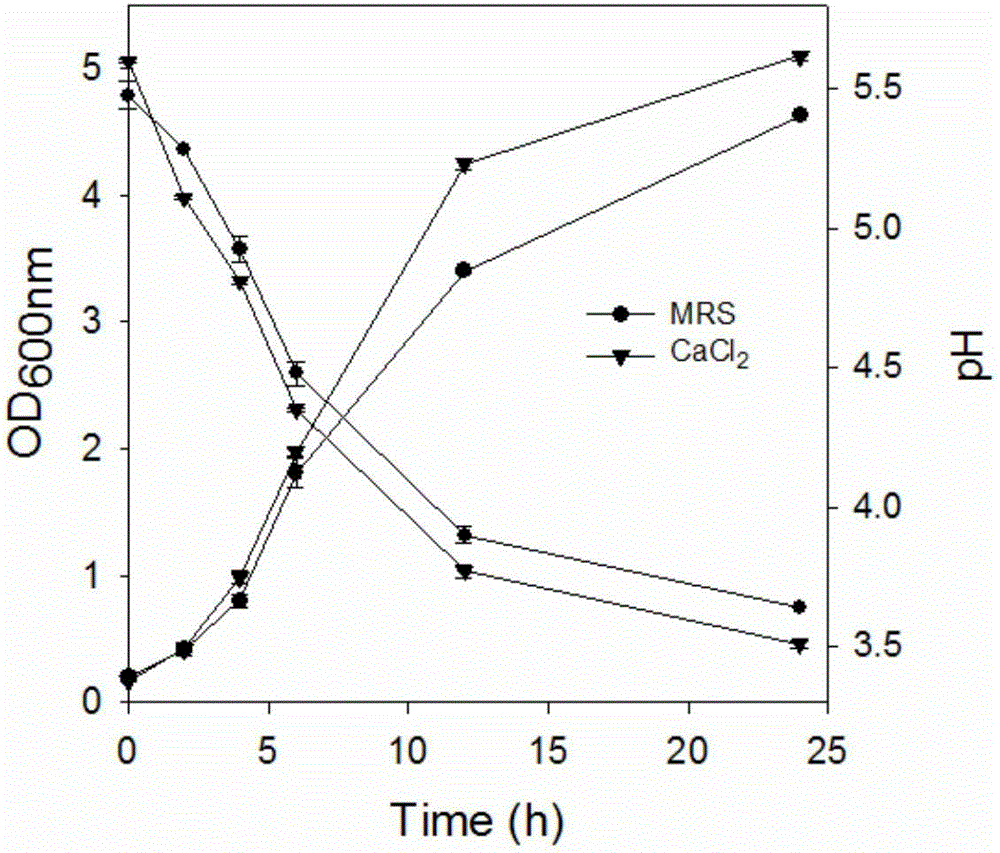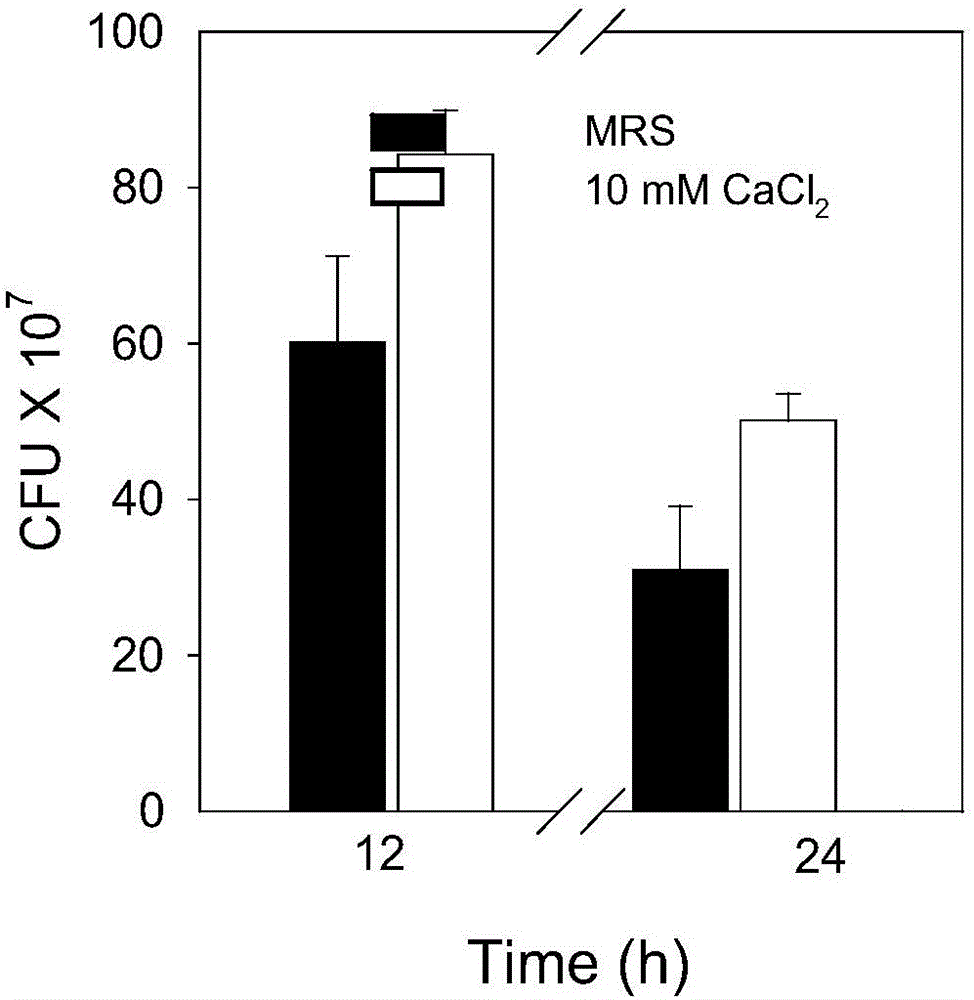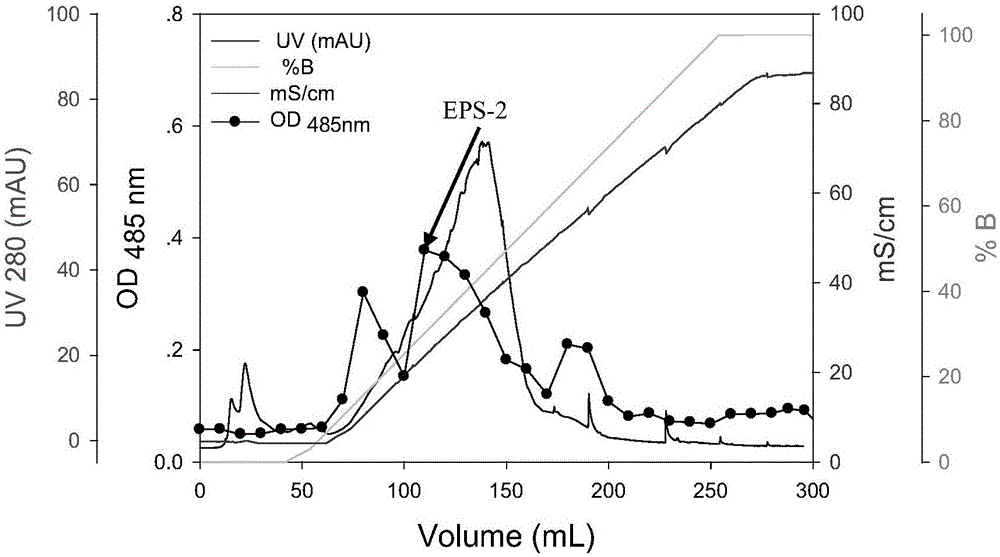Method for purifying lactobacillus rhamnosus extracellular polysaccharides
A technology of Lactobacillus rhamnosus and extracellular polysaccharide, applied in the field of extracellular polysaccharide, can solve problems such as complicated steps and the like
- Summary
- Abstract
- Description
- Claims
- Application Information
AI Technical Summary
Problems solved by technology
Method used
Image
Examples
Embodiment 1
[0043] Example 1: CaCl 2 Promotes the growth of Lactobacillus rhamnosus
[0044] During the fermentation process, there was a linear correlation between the number of live lactic acid bacteria and the absorbance in the fermented liquid with skim milk as the medium. Therefore, the number of viable lactic acid bacteria in fermented dairy products can be assessed by measuring the absorbance of the fermented broth. Simultaneously detect the pH value of the fermentation broth.
[0045] 1) Medium:
[0046] 1. MRS liquid medium (g / L): glucose 20, beef extract 10, Peptone 10, yeast powder 5, ammonium citrate 1, sodium acetate 5, KH 2 PO 4 2, MgSO 4 ·7H 2 O 0.05, MnSO 4 ·H 2 O 0.05, pH 6-6.5.
[0047] 2. MRS solid medium (g / L): glucose 20, beef extract 10, Peptone 10, yeast powder 5, ammonium citrate 1, sodium acetate 5, KH 2 PO 4 2, MgSO 4 ·7H 2 O 0.05, MnSO 4 ·H 2 O 0.05, agar powder 15, pH 6-6.5.
[0048] 2) Sterile CaCl 2 Preparation of solution
[0049] CaC...
Embodiment 2
[0066] Example 2: CaCl 2 Increase the number of live bacteria of Lactobacillus rhamnosus
[0067] The colony counting method is used to calculate the total number of bacteria, which does not include the number of dead bacteria, so it can accurately reflect the number of viable bacteria in the fermentation broth.
[0068] 1) Cultivate bacteria according to the culture method of Example 1. After culturing for 12h or 24h, take a 1ml fermentation broth sample and dilute it step by step to 10 with sterile water. -7 times. Take 10 of the fermentation broth samples under the two conditions respectively -6 and 10 -7 Double the two dilutions, draw 50 μl of the diluted bacterial solution and evenly spread it on the MRS solid medium plate, and incubate at 37°C for 48h. Take out the petri dish and plate, and pay attention to the distinction of tiny colonies, small insoluble particles or sediments on the plate during the counting process, carefully investigate and deal with suspicious ...
Embodiment 3
[0072] Embodiment 3: application example
[0073] Escherichia coli BL21 (E.coli BL21), Staphylococcus aureus (B.cereus), and Bacillus cereus (S.aureus) were selected for antibacterial experiments. The specific operation is as follows:
[0074] 1) Escherichia coli BL21 and Bacillus cereus were inoculated into LB liquid medium and cultured for 12 hours at a rotation speed of 200 rpm, and set aside. Staphylococcus aureus was inoculated into TSB liquid medium and cultured for 12 hours at a rotation speed of 150 rpm, and then set aside.
[0075] 2) Punch the filter paper with a puncher with an inner diameter of 5 mm to obtain several circular filter paper pieces with uniform inner diameter, and then sterilize.
[0076] 3) Prepare a certain amount of LB and TSB liquid and agar medium, and sterilize.
[0077]4) Put Lactobacillus rhamnosus in MRS liquid medium and add 10mM CaCl 2 The MRS was cultured (37°C, static) for 12 hours, and set aside.
[0078] 5) After heating and meltin...
PUM
| Property | Measurement | Unit |
|---|---|---|
| Diameter | aaaaa | aaaaa |
Abstract
Description
Claims
Application Information
 Login to View More
Login to View More - R&D
- Intellectual Property
- Life Sciences
- Materials
- Tech Scout
- Unparalleled Data Quality
- Higher Quality Content
- 60% Fewer Hallucinations
Browse by: Latest US Patents, China's latest patents, Technical Efficacy Thesaurus, Application Domain, Technology Topic, Popular Technical Reports.
© 2025 PatSnap. All rights reserved.Legal|Privacy policy|Modern Slavery Act Transparency Statement|Sitemap|About US| Contact US: help@patsnap.com



